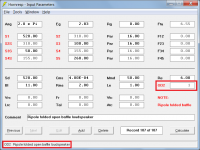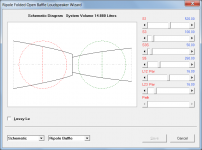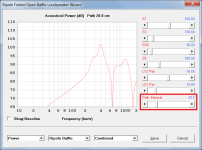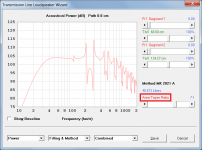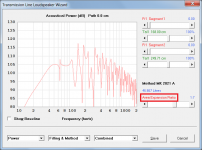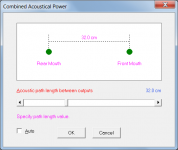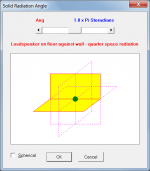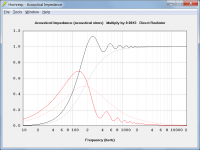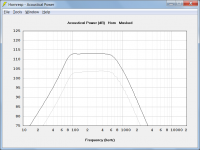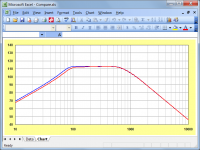Finally i found a solution, thank you for everyone that helped 
solution was easy :
get the ms sans serif font file from a windows device and then past it in my .wine/drive_c/windows/fonts folder on my linux device. then hornresp launched properly
the font file is in attachement (sserife.fon).
solution was easy :
get the ms sans serif font file from a windows device and then past it in my .wine/drive_c/windows/fonts folder on my linux device. then hornresp launched properly
the font file is in attachement (sserife.fon).
Attachments
Hornresp Update 5440-221015
Hi Everyone,
CHANGE 1
A ripole loudspeaker can now have an odd number of drivers, side panels can be non-parallel, and the path length can be manually set. Attachments 1 to 3 refer.
CHANGE 2
Methods MK 2006 and MK 2021 in the TL Design tool now support both tapered and expanding transmission lines. Double-click on the 'Area Taper Ratio' label to specify an expanding transmission line. Attachments 4 and 5 refer.
BUG FIX
The bug reported by Kees in Post #13,116 has now hopefully been fixed.
Kind regards,
David
Hi Everyone,
CHANGE 1
A ripole loudspeaker can now have an odd number of drivers, side panels can be non-parallel, and the path length can be manually set. Attachments 1 to 3 refer.
CHANGE 2
Methods MK 2006 and MK 2021 in the TL Design tool now support both tapered and expanding transmission lines. Double-click on the 'Area Taper Ratio' label to specify an expanding transmission line. Attachments 4 and 5 refer.
BUG FIX
The bug reported by Kees in Post #13,116 has now hopefully been fixed.
Kind regards,
David
Attachments
if someone here is using linux and hornresp together, maybe just sending the font file and telling me in which directory to place it will work no ?
I have these fonts installed as system fonts in /usr/share/fonts/TTF/
As root user:
wget http://avi.alkalay.net/software/webcore-fonts/webcore-fonts-3.0.tar.gz
tar vxf webcore-fonts-3.0.tar.gz
cd webcore-fonts
mkdir -p /usr/share/fonts/TTF
cp fonts/* /usr/share/fonts/TTF
cp vista/* /usr/share/fonts/TTF
# Update the X font indexes:
cd /usr/share/fonts/TTF
mkfontscale .
mkfontdir .
/usr/bin/fc-cache -f
Hornresp Update 5440-221015
Hi Everyone,
CHANGE 1
A ripole loudspeaker can now have an odd number of drivers, side panels can be non-parallel, and the path length can be manually set. Attachments 1 to 3 refer.
CHANGE 2
Methods MK 2006 and MK 2021 in the TL Design tool now support both tapered and expanding transmission lines. Double-click on the 'Area Taper Ratio' label to specify an expanding transmission line. Attachments 4 and 5 refer.
BUG FIX
The bug reported by Kees in Post #13,116 has now hopefully been fixed.
Kind regards,
David
"change 2": many thanks David. This will certainly help with comparing options and tradeoffs between the different enclosures. I had a play with default settings for the 2021 MJK B method. A useful starting point on the journey of deciding a practical enclosure to be built.Hornresp Update 5440-221015
Hi Everyone,
CHANGE 1
A ripole loudspeaker can now have an odd number of drivers, side panels can be non-parallel, and the path length can be manually set. Attachments 1 to 3 refer.
CHANGE 2
Methods MK 2006 and MK 2021 in the TL Design tool now support both tapered and expanding transmission lines. Double-click on the 'Area Taper Ratio' label to specify an expanding transmission line. Attachments 4 and 5 refer.
BUG FIX
The bug reported by Kees in Post #13,116 has now hopefully been fixed.
Kind regards,
David
Attachments
That is really awesome, very useful additions, thanks!CHANGE 1
A ripole loudspeaker can now have an odd number of drivers, side panels can be non-parallel, and the path length can be manually set. Attachments 1 to 3 refer.
Two thoughts came up to me, as the SPL of ripole simulations seem to be surprisingly high, but in reality riploles are considered to be not very efficient:
-The boost by the rear wall in a quarter(and eight) space radiation should probably not be taken into account, as it is effectively replaced by the "Path" setting.
-Is the loss of energy for the sound traveling(to real wall and back to the speaker panel) along the "Path" taken into account?
-Is the loss of energy for the sound traveling(to real wall and back to the speaker panel) along the "Path" taken into account?
Just to clarify - the "Path" length is the distance between the two point source outputs. There is no loss of energy.
For further information see Post #10,453 linked below, and the three further references contained in that post.
https://www.diyaudio.com/community/threads/hornresp.119854/page-523#post-6069923
Attachments
Hi I have a couple questions related to impedance. Ive designed a horn to be used in the 80-200 Hz band and have achieved my desired response but am struggling to shift the second impedance spike out of the operating range.
1) How much of an effect will this spike have on the performance and how important it is for me to try get rid of it while juggling other important aspects of the horn.
2) If there is, what is the most effective way to reduce/remove this impedance? I have attached a photo of the horn and impedance graph.
All help and advice appreicated.


1) How much of an effect will this spike have on the performance and how important it is for me to try get rid of it while juggling other important aspects of the horn.
2) If there is, what is the most effective way to reduce/remove this impedance? I have attached a photo of the horn and impedance graph.
All help and advice appreicated.
Thank you for these infos.Just to clarify - the "Path" length is the distance between the two point source outputs. There is no loss of energy.
For further information see Post #10,453 linked below, and the three further references contained in that post.
https://www.diyaudio.com/community/threads/hornresp.119854/page-523#post-6069923
So this is true regardless if it'a monopol+port(radiating in all directions) or dipole(radiating in opposite directions). What confuses me is how to get the distance of the rear wall into the simulation, as this is more crucial for dipoles than with monopoles because of the 180° phase shift to the rear, which adds or cancels when arriving at the listening position depending on frequency, and it also looses some db on the journey.The combined power response of two sources is dependent on their individual magnitude/phase, and the separation distance between them. The pressure response @ 1m is then calculated for a point source having the equivalent power response. The relative distances between listener and sources does not come into play, only the separation distance between the sources.
From https://www-dipolplus-de.translate...._sl=de&_x_tr_tl=en&_x_tr_hl=en&_x_tr_pto=wapp :
- If the path from the back of the membrane via the front wall back to the level of the baffle is an odd multiple of half the wavelength, then this sound meets the sound from the front of the membrane offset by another half wavelength. Reinforcement is coming.
- If this path is an even multiple of half the wavelength, then this sound meets the sound from the front of the membrane without any offset. It weakens.
The solid angle into which the system radiates can be specified, but not the distance to the reflecting surface.What confuses me is how to get the distance of the rear wall into the simulation
Attachments
Not sure if it applies in this case, but I often find it more insightful to specify the last segment as being infinite and then I can control the space much better.The solid angle into which the system radiates can be specified, but not the distance to the reflecting surface.
A loudspeaker terminated by an infinite conical segment having the same solid angle as that specified by the Ang parameter, will produce different results to those obtained using just the loudspeaker and Ang value.
To illustrate:
Attachment 1 shows the normalised acoustical impedance at the mouth of the default horn system when Ang = 0.5 x Pi (dark traces) compared to the mouth impedance of the same system when terminated by an infinite conical segment with Fta = 41.5 degrees (light traces).
Attachment 2 shows the power response of the default horn system when Ang = 0.5 x Pi (dark trace) compared to the response of the same system when terminated by an infinite conical segment with Fta = 41.5 degrees (light trace).
Also, a combined response cannot be obtained when an infinite segment is used.
To illustrate:
Attachment 1 shows the normalised acoustical impedance at the mouth of the default horn system when Ang = 0.5 x Pi (dark traces) compared to the mouth impedance of the same system when terminated by an infinite conical segment with Fta = 41.5 degrees (light traces).
Attachment 2 shows the power response of the default horn system when Ang = 0.5 x Pi (dark trace) compared to the response of the same system when terminated by an infinite conical segment with Fta = 41.5 degrees (light trace).
Also, a combined response cannot be obtained when an infinite segment is used.
Attachments
But why is the response different? Shouldn't they be the same? Why does Hornresp treat them differently?A loudspeaker terminated by an infinite conical segment having the same solid angle as that specified by the Ang parameter, will produce different results to those obtained using just the loudspeaker and Ang value.
To illustrate:
Attachment 1 shows the normalised acoustical impedance at the mouth of the default horn system when Ang = 0.5 x Pi (dark traces) compared to the mouth impedance of the same system when terminated by an infinite conical segment with Fta = 41.5 degrees (light traces).
Attachment 2 shows the power response of the default horn system when Ang = 0.5 x Pi (dark trace) compared to the response of the same system when terminated by an infinite conical segment with Fta = 41.5 degrees (light trace).
Also, a combined response cannot be obtained when an infinite segment is used.
Maybe think of it from the other end. The environment is the "load" on the speaker. Because the environment is different, the "load" is different and the results are different.
https://trueaudio.com/st_spcs1.htm
https://trueaudio.com/st_spcs1.htm
Yes, but why is it different? They both have the same solid angle so the loudspeaker should be seeing the same load. Maybe it's the abrupt transition from circular cross section to triangular that is creating the discontinuity, causing some sound to be reflected back to the throat.Maybe think of it from the other end. The environment is the "load" on the speaker. Because the environment is different, the "load" is different and the results are different.
https://trueaudio.com/st_spcs1.htm
With the infinite segment included it is not possible to determine the absolute level of the power response because there is no finite mouth area upon which to base the calculations. In order to produce a power response chart for the infinite case, for the purposes of the calculations Hornresp arbitrarily assumes a 4 x Pi environment. To directly compare the infinite results with those for Ang = 0.5 x Pi it is therefore necessary to add 3 x 3 dB (4Pi->2Pi->1Pi->Pi/2) or 9 dB to the infinite results. When this is done the comparison chart is as shown in the attachment (blue trace = 0.5 x Pi, red trace = infinite segment).Yes, but why is it different?
The remaining difference at the low frequency end is because Hornresp uses the standard 1P (one parameter) horn loudspeaker model, which assumes that under 2 x Pi conditions the radiation impedance at the mouth is that of a circular vibrating piston in an infinite baffle. The radiation impedance is adjusted accordingly when the specified solid angle is other than 2 x Pi. As shown in Attachment 1 in my previous post, the impedance so determined is never going to be the same as that at the throat of an infinite conical horn. For one thing, there will be no ripples in the infinite horn throat impedance because there is no mouth impedance mismatch to produce reflections.
Attachments
Last edited:
This is basically a limitation of the 1D radiation models, where you have to make assumptions about the shape of the wave front instead of letting it be calculated from the geometry (boundary conditions) using the wave equation. The piston model assumes a plane wave at the mouth, while an infinite conical horn assumes spherical waves.
Hey everyone,
I'm wondering what region I should be tuning my horn for a high low/low mid kick bin, the fs of the driver is 54 Hz. I currently have it tuned to around 85 Hz however am un sure whether i should be aiming for a higher or lower tuning frequency.
All advice and help appreciated.
TIA
I'm wondering what region I should be tuning my horn for a high low/low mid kick bin, the fs of the driver is 54 Hz. I currently have it tuned to around 85 Hz however am un sure whether i should be aiming for a higher or lower tuning frequency.
All advice and help appreciated.
TIA
Kick is generally in the 120 hertz region. There are weaker subharmonics and stronger upper harmonics. So a good kick bin about 80hz to 240hz if you are tuning for ultimate efficiency.Hey everyone,
I'm wondering what region I should be tuning my horn for a high low/low mid kick bin, the fs of the driver is 54 Hz. I currently have it tuned to around 85 Hz however am un sure whether i should be aiming for a higher or lower tuning frequency.
All advice and help appreciated.
TIA
Just updated my Hornresp, and I became unable to use the numpad for decimal values.
Here we use comma to differentiate between whole numbers and decimals here, and single space between triple zeroes.
So there I am, having to move my hand from the numpad, all the way over to the period sign, punch that, then move my hand all the way back over to the numpad again. I guess I could focus intently and use my other hand, but it's not meant for interacting with number crunching and with the intense mental struggle of calculating the desired arm movement requires at least 0.3 seconds activation time before anything happens.
And this is not calculating the shift of focus, which produces a loss easily in the area of 2 seconds, perhaps even more.
See here, all dots everywhere:

I did not have this problem before updating for some strange reason, and I was not really suspecting your fine software because I found an older installation file that produces the same result, so it must be some sort of Windows Update crap.
After a thorough investigation on the matter it seems like something has happened that changed my settings for area and date format under advanced settings to English(Great Britain) for some reason, changed it back to Norwegian and now it works.
So, after going through an arduous mental struggle of having to involve my left hand in numpad business and the excruciating process of finding and rectifying the problem, nothing is wrong with Hornresp and I am able to hammer on as usual.
Thank you again for Hornresp, David. Greatly appreciate it. And the new functions you are adding to the software makes it very versatile.
It is the most lightweight advanced program for calculating loudspeakers, everything else is cumbersome at best in comparison to this little marvel weighing in at 6.33MB in a fresh install, very impressive in todays world.
Here we use comma to differentiate between whole numbers and decimals here, and single space between triple zeroes.
So there I am, having to move my hand from the numpad, all the way over to the period sign, punch that, then move my hand all the way back over to the numpad again. I guess I could focus intently and use my other hand, but it's not meant for interacting with number crunching and with the intense mental struggle of calculating the desired arm movement requires at least 0.3 seconds activation time before anything happens.
And this is not calculating the shift of focus, which produces a loss easily in the area of 2 seconds, perhaps even more.
See here, all dots everywhere:
I did not have this problem before updating for some strange reason, and I was not really suspecting your fine software because I found an older installation file that produces the same result, so it must be some sort of Windows Update crap.
After a thorough investigation on the matter it seems like something has happened that changed my settings for area and date format under advanced settings to English(Great Britain) for some reason, changed it back to Norwegian and now it works.
So, after going through an arduous mental struggle of having to involve my left hand in numpad business and the excruciating process of finding and rectifying the problem, nothing is wrong with Hornresp and I am able to hammer on as usual.
Thank you again for Hornresp, David. Greatly appreciate it. And the new functions you are adding to the software makes it very versatile.
It is the most lightweight advanced program for calculating loudspeakers, everything else is cumbersome at best in comparison to this little marvel weighing in at 6.33MB in a fresh install, very impressive in todays world.
- Home
- Loudspeakers
- Subwoofers
- Hornresp
